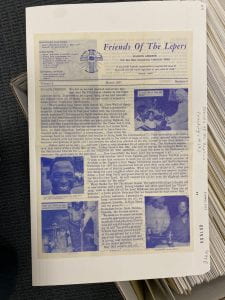
Mixed A/V Material
In my 130 hours working as an intern on the Hall Hoag Collection, I’ve learned about extremism, A/V formats, and listened to several rambling audiocassette letters about white supremacy. I spent the first half of my internship working with the audiovisual component of the collection, which consists of cassette tapes, Kodachrome film, VHS, Betamax, U-Matic, various sizes of reel-to-reel tapes, and a few stray floppy disks. The content ranges from home video of extremist party rallies to sermons from tape ministries to recordings of KKK songs. All in all, there are close to 500 items in this subseries, and I created PBCore records for all of them, ensuring that researchers will have as much information as possible when searching for relevant materials. I’m excited that this fascinating material is going to be available to researchers who are interested in all kinds of extremist and dissenting propaganda.
I was also able to create processing plans for six other subseries in the collection – apart from the main components, Hall Hoag I and II, and the A/V materials, there are also books, index cards, personal correspondence, oversized materials, clippings, and unidentified materials. These plans will help future archivists determine what to do with these subseries in the future. For example, I think that someone might one day want to use the collection to study not the extremist groups Gordon Hall collected materials from, but Hall himself; I certainly hope that someone writes his biography, because I’d love to read it! Therefore, I recommended retaining all his personal correspondence and documents in my processing plan, even those that aren’t related to politics or extremism.

Gordon Hall
Another component of my internship involved streamlining spreadsheets containing lists of all the groups and people whose materials are represented in the collection. This meant that, while I didn’t interact with the physical documents they created, I was able to see the names and locations of a truly staggering array of organizations. In Hall’s experience, some groups that started out innocuous later veered into extremism, so he collected materials from organizations like the Audubon Society alongside the American Nazi Party. I have to confess to being amused by the names of some of the truly hateful organizations, and writing down my favorites, like “Nazis for Hitler” (redundant?) and “Society To Remove All Immoral Godless Homosexual Trash,” aka “STRAIGHT,” aka I respect their acronym game almost as much as I abhor their politics. There are over 30,000 groups and people represented in the collection, so going through those spreadsheets took some time! Organizing information is deeply satisfying to me, though, so it was an enjoyable process.
I learned a lot about a wide variety of archival practices, as well as extremist groups, during this internship, and I’m really happy that my work has contributed to making the Hall Hoag Collection more accessible to researchers. The material in this collection is by turns fascinating and horrifying, and I hope that it will continue to contribute to a body of scholarship about extremist groups.



























